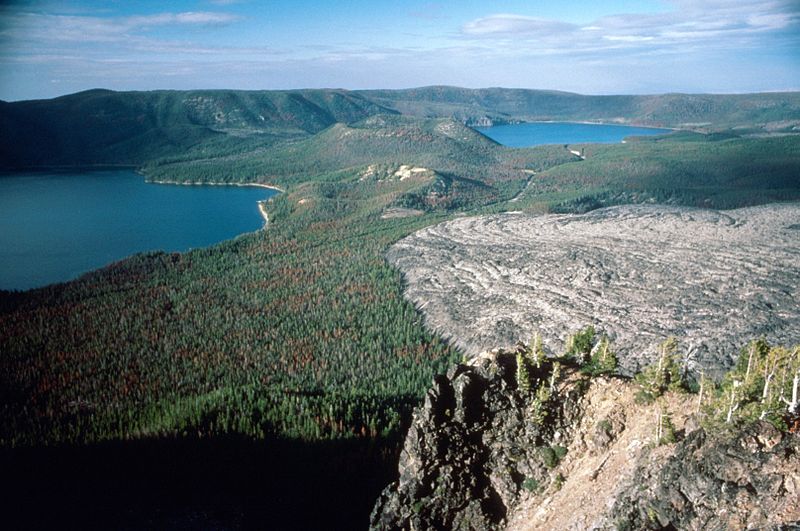Geothermal engineering in Newberry volcano
By Peter Janetos, ESA public affairs intern

Newberry Caldera. USGS photo by Lyn Topinka
In the quest for cleaner, greener, and cheaper energy some are looking 10,000 feet below central Oregon where temperatures exceed 600 degrees Fahrenheit in Newberry Volcano. A recent Popular Science article takes a closer look at this latest initiative for renewable energy. Deschutes National Forest is home to the volcano, where AltaRock Energy Inc. plans to perform enhanced geothermal engineering, or EGS, to generate renewable energy. EGS is the process of extracting geothermal energy from naturally occurring resources such as hot springs, underground gases, or in this case a volcano. Called The Newberry Project, after the volcano, the project was started back in October 2012.
As reported by Jeff Barnard in the Huffington Post, the federal government and private investors, such as Google, are investing $43 million in the project. Barnard notes that heat in the earth’s crust has been used to generate power for over a hundred years by gathering hot water or steam that bubbles near the surface to spin a turbine that creates electricity. The “new frontier” of EGS are locations with hot rocks but without the cracks in the rocks or water to deliver the steam.
Head of the Newberry Project is President and CEO of AltaRock, Susan Petty, who founded the company in 2007. According to Petty, “We know the heat is there. The big issue is can we circulate enough water through the system to make it economic.”
AltaRock extracts thermal energy produced by the volcano by pouring thousands of gallons of water deep into preexisting fractures underground and then mechanically pumping the water which becomes super heated. The heated water is then pushed through a second pump which sends it through a turbine to produce energy before eventually shooting it back into the fractures, in a continuous loop. There are drawbacks, of which earthquakes are the most obvious. The water pumped underground exerts a force around 2,400 pounds per square inch against the earth’s walls. Natural cracks in rocks are expanded and can trigger earthquakes. Since the projected started, AltaRock has recorded 219 earthquakes.
Trenton Cladouhos is AltaRock’s Senior Vice President of Research and Development and said the largest earthquake they’ve recorded was at a magnitude of 2.4. According to Cladouhos, most of the earthquakes were around or under magnitude 1, barely felt by most people. The company says it has a system in place to shut down production completely if necessary.
“There’s never guarantees in any kind of geothermal situation,” said CEO Petty.
However, a geoengineering effort in Switzerland sparked a series of earthquakes that resulted in considerable damage and likely contributed to a perception that the process is more dangerous than it may be. But the data are limited.
“There’s not a lot of cases to look at in terms of enhanced geothermal engineering systems,” said David Oppenheimer, a scientist at the US Geological Survey.
The Popular Science article notes similarities between geoengineering technology and hydraulic fracturing:
“The process is called “hydroshearing,” and if you know anything about harvesting energy, you know that it sounds eerily reminiscent of hydraulic fracturing, or “fracking”. Fracking is the controversial practice of dumping chemical cocktails and water underground to fracture rocks and release petroleum or natural gas.”
The Bureau of Land Management conducted an environmental analysis that found no significant impact is likely from the Newberry Project.
If the ongoing experiment at Newberry is deemed a success, how much energy could it produce and how would it impact US energy consumption? Are the earthquakes and other aspects of this enterprise worth the outcome? According to the Natural Resources Defense Council, in 2010, EGS projects all across the country produced a combined total of only 3,000 megawatts of energy, accounting for about half a percent of total US energy consumption. However, proponents argue that EGS has the potential to create its own hydrothermal reservoirs by pouring water into preexisting fractures and even creating new ones. AltaRock claims it can already do this and that it could account for up to 10 percent of American energy.
The US Department of Energy estimates that within the next 50 years, EGS could contribute at least 100,000 megawatts of electricity to the US. It’s a growing field and geothermal engineering could very well be the next source for clean renewable energy.